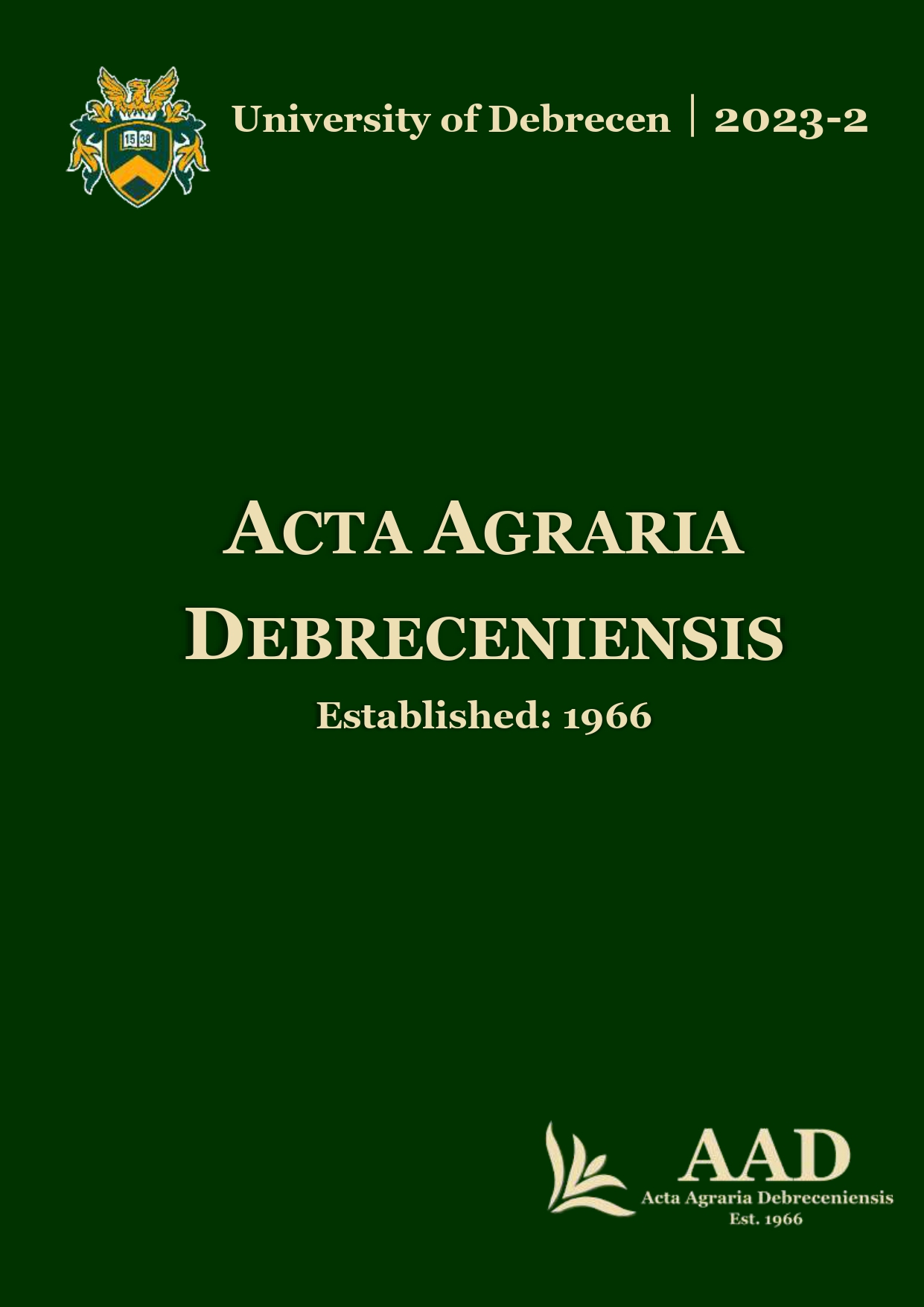How have thermal conditions changed in different phenological stages of apple (Malus domestica) in Northeastern Hungary?
Authors
View
Keywords
License
Copyright (c) 2023 by the Author(s)

This work is licensed under a Creative Commons Attribution 4.0 International License.
How To Cite
Accepted 2023-10-06
Published 2023-12-01
Abstract
In temperate climates, most fruit trees need cold weather, low temperatures in winter, and a certain amount of heat during the growing season until harvest. One of the most apparent effects of climate change is the elevated temperature in all seasons of the year. In our study, the changes in thermal conditions have been calculated in Hungary's most significant growing region of apples using the Chill Unit for winters and the Growing Degree Days for summers. The meteorological data were obtained from the gridded dataset of the Hungarian Meteorological Service on a 10 km × 10 km grid, so the whole studied area is well-covered over the last 50 years. The results show that the trees are more exposed to early budding than a few decades ago. Furthermore, the accumulated heat amount in summers has increased drastically, which may increase the heat stress and lead to higher yield losses.
References
- Aguilera, F.–Ruiz, L.–Fornaciari, M.–Romano, B.–Galán, C.–Oteros, J.–Dhiab, A.B.–Msallem, M.–Orlandi, F. (2014): Heat accumulation period in the Mediterranean region: phenological response of the olive in different climate areas (Spain, Italy and Tunisia). Int J Biometeorol, 58, 867–876. https://doi.org/10.1007/s00484-013-0666-7,
- Alene, T. (2021): Apple production and management training report in Debre Birhan, Ethiopia, International Livestock Research Institute, Ethiopia, African-Rising, p 9. (https://cgspace.cgiar.org/bitstream/handle/10568/113139/Apple%20training_2021.pdf?sequence=1)
- Campoy, J.A.–Ruiz, D.–Egea J. (2011): Dormancy in temperate fruit trees in a global warming context: A review. Sci. Hortic., 30(2), 357–372. https://doi.org/10.1016/j.scienta.2011.07.011,
- Chmielewski, F.M.–Blümel, K.–Pálešová, I. (2012): Climate change and shifts in dormancy release for deciduous fruit crops in Germany. Clim Res, 54, 209–219. https://doi.org/10.3354/cr01115,
- Delgado, A.–Dapena, E.–Fernandez, E.–Luedeling, E. (2021): Climatic requirements during dormancy in apple trees from northwestern Spain – Global warming may threaten the cultivation of high-chill cultivars. Eur J Agron, 130:126374, https://doi.org/10.1016/j.eja.2021.126374.
- Dennis, F.G. (2003): Problems in standardizing methods for evaluating the chilling requirements for the breaking of dormancy in buds of woody plants HortScience, 38, 347–350. https://doi.org/10.21273/HORTSCI.38.3.347,
- Funes, I.–Aranda, X.–Biel, C.–Carbó, J.–Camps, F.–Molina, A.J.–de Herralde, F.–Grau, B.–Savé, R. (2016): Future climate change impacts on apple flowering date in a Mediterranean subbasin, Agric Water Manag, 164(1), 19–27. https://doi.org/10.1016/j.agwat.2015.06.013
- Hauagge, R.–Cummins, J.N. (1991): Phenotypic variation of length of bud dormancy in apple cultivars and related Malus species. J. Amer. Soc. Hort. Sci, 116, 100–106. https://doi.org/10.21273/JASHS.116.1.100
- Helder, F.–Santos João A. (2021): Assessment of Climate Change Impacts on Chilling and Forcing for the Main Fresh Fruit Regions in Portugal. Front Plant Sci, 12, https://doi.org/10.3389/fpls.2021.689121
- Huo, L.–Sun, X.–Guo, Z.–Jia, X.–Che, R.–Sun, Y....–Ma, F. (2020): MdATG18a overexpression improves basal thermotolerance in transgenic apple by decreasing damage to chloroplasts. Horticulture research, 7.
- IPCC (2022): Climate Change 2022: Impacts, Adaptation, and Vulnerability. Contribution of Working Group II to the Sixth Assessment Report of the Intergovernmental Panel on Climate Change [H.-O. Pörtner, D.C. Roberts, M. Tignor, E.S. Poloczanska, K. Mintenbeck, A. Alegría, M. Craig, S. Langsdorf, S. Löschke, V. Möller, A. Okem, B. Rama (eds.)]. Cambridge University Press. Cambridge University Press, Cambridge, UK and New York, NY, USA, 3056 pp., doi:10.1017/9781009325844.
- Kaukoranta, T.–Tahvonen, R.–Ylämäki, A. (2010): Climatic potential and risks for apple growing by 2040. Agric. Food Sci, 19, 144–159. https://doi.org/10.2137/145960610791542352,
- KSH. (2022, augusztus 15.): Fontosabb gyümölcsfélék és a szőlő betakarított területe. Összefoglaló Táblák (STADAT). https://www.ksh.hu/stadat_files/mez/hu/mez0014.html
- Lang, G.A.–Early, J.D.–Martin, G.C.–Darnell, R.L. (1987): Endo-, para-, and ecodormancy: physiological terminology and classification for dormancy research. HortSci, 22, 371–377. https://doi.org/10.21273/HORTSCI.22.5.701b,
- R Core Team (2022): R: A Language and Environment for Statistical Computing. R Foundation for Statistical Computing, Vienna, Austria. https://www.R-project.org/
- Ramírez, F.–Kallarackal, J. (2015): Climate Change and Chilling Requirements. In: Responses of Fruit Trees to Global Climate Change. Springer Briefs in Plant Science. Springer, Cambridge, UK, https://doi.org/10.1007/978-3-319-14200-5_9
- Richardson, E.A.–Seeley, S.D.–Walker, D.R. (1974): A model for estimating the completion of rest for “Redhaven” and “Elberta” peach trees. HortSci, 9, 331–332. https://doi.org/10.21273/HORTSCI.9.4.331,
- Rochette, P.–Bélanger, G.–Castonguay, Y.–Bootsma, A.– Mongrain, D. (2011): Climate change and winter damage to fruit trees in eastern Canada. Can. J Plant Sci., 84(4), https://doi.org/10.4141/P03-177, 1113-1125.
- Rodríguez, A.–Pérez-López, D.–Sánchez, E.–Centeno, A.–Gómara, I.–Dosio, A.–Ruiz-Ramos, M. (2019): Chilling accumulation in fruit trees in Spain under climate change, Nat. Hazards Earth Syst. Sci., 19, 1087–1103. https://doi.org/10.5194/nhess-19-1087-2019
- Salama, A.-M.–Ezzat, A.–El-Ramady, H.–Alam-Eldein, S.M.–Okba, S.K.–Elmenofy, H.M.–Hassan, I.F.–Illés, A.–Holb, I.J. (2021): Temperate Fruit Trees under Climate Change: Challenges for Dormancy and Chilling Requirements in Warm Winter Regions. Horticulturae, 2021(7), 86. https://doi.org/10.3390/horticulturae7040086,
- Somfalvi-Tóth, K. (2020): A kukoricatermesztés feltételeinek változása 1901-től napjainkig. Agrofórum Extra, 87, 16–18.
- Szabó, T.–Lakatos, L.T.–Vaszily, B.–Lakatos, L. (2017): Climate Change Effects on Apple and Sour Cherry Phenology in a Gene Bank Plantation of Hungary. Aerul Si Apa.Componente Ale Mediului, 251–258. Retrieved from https://www.proquest.com/scholarly-journals/climate-change-effects-on-apple-sour-cherry/docview/1973390776/se-2
- Tamás, J. (2011): Almaültetvények vízkészlet-gazdálkodása, Debreceni Egyetem, AGTC, Kutatási és Fejlesztési Intézet, Kecskeméti Főiskola, Kertészeti Főiskolai Kar, ISBN 978-963-9732-99-5, 298.
- Tworkoski, T.–Fazio, G.–Glenn, D.M. (2016): Apple rootstock resistance to drought. Scientia Horticulturae, 204, 70–78.
- Vujadinović Mandić, M.–Vuković Vimić, A.–Fotirić Akšić M.–Meland M. (2023): Climate Potential for Apple Growing in Norway—Part 2: Assessment of Suitability of Heat Conditions under Future Climate Change. Atm., 14(6), 937. https://doi.org/10.3390/atmos14060937,

 https://doi.org/10.34101/actaagrar/2/13162
https://doi.org/10.34101/actaagrar/2/13162